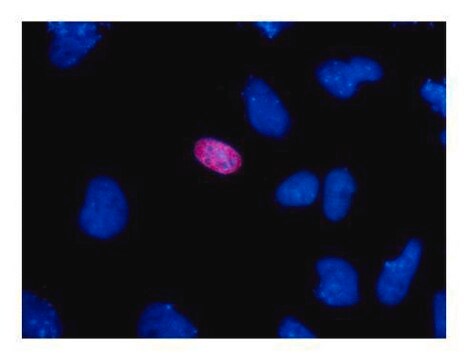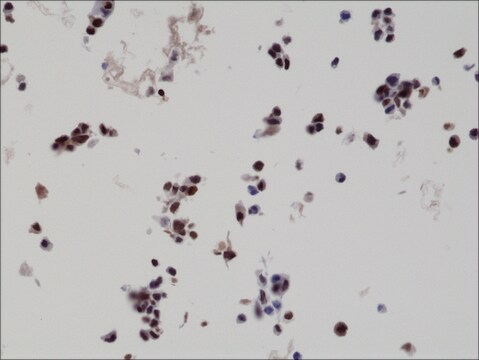04-902
Anti-HA Tag Antibody, clone DW2, rabbit monoclonal
culture supernatant, clone DW2, from rabbit
About This Item
Prodotti consigliati
Origine biologica
rabbit
Livello qualitativo
Forma dell’anticorpo
culture supernatant
Tipo di anticorpo
primary antibodies
Clone
DW2, monoclonal
Reattività contro le specie
vertebrates (common species)
tecniche
western blot: suitable
Isotipo
IgG
Condizioni di spedizione
dry ice
modifica post-traduzionali bersaglio
unmodified
Descrizione generale
Specificità
Immunogeno
Applicazioni
Epitope Tags & General Use
Epitope Tags
Qualità
Lysates from non-transfected (lane 1) and HAtagged WNT-1 transfected (lane 2) HEK293 cells were resolved by electrophoresis, transferred to nitrocellulose and probed with anti-HA-Tag, clone DW2 (1:1,000 dilution).
Proteins were visualized using a goat anti-rabbit secondary antibody conjugated to HRP and a chemiluminescence detection system.
Arrow indicates the HA-tagged protein (~49 kDa). The apparent molecular weight is related to the tagged protein.
Descrizione del bersaglio
Linkage
Stato fisico
Stoccaggio e stabilità
Risultati analitici
HA-tagged WNT-1 protein.
Esclusione di responsabilità
Non trovi il prodotto giusto?
Prova il nostro Motore di ricerca dei prodotti.
Codice della classe di stoccaggio
12 - Non Combustible Liquids
Classe di pericolosità dell'acqua (WGK)
WGK 1
Punto d’infiammabilità (°F)
Not applicable
Punto d’infiammabilità (°C)
Not applicable
Certificati d'analisi (COA)
Cerca il Certificati d'analisi (COA) digitando il numero di lotto/batch corrispondente. I numeri di lotto o di batch sono stampati sull'etichetta dei prodotti dopo la parola ‘Lotto’ o ‘Batch’.
Possiedi già questo prodotto?
I documenti relativi ai prodotti acquistati recentemente sono disponibili nell’Archivio dei documenti.
I clienti hanno visto anche
Il team dei nostri ricercatori vanta grande esperienza in tutte le aree della ricerca quali Life Science, scienza dei materiali, sintesi chimica, cromatografia, discipline analitiche, ecc..
Contatta l'Assistenza Tecnica.








